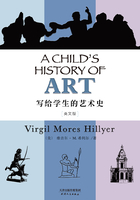

05
JARS AND JUGS
BUT one kind of Greek painting has lasted, examples of which are in many museums. These are the paintings that were made on vases.
Our vases are made out of glass, china, or copper, and are usually for one purpose — to hold flowers. We don't usually paint or even decorate the outside. But Greek vases were all made out of clay and they were not used for flowers at all. They were used to hold anything liquid — water, wine, oil, ointments, perfumes — as we would use jars and jugs, bottles and bowls, cups and kettles, pitchers or tin cans. They were made in many beautiful shapes. Some were tall and thin, some were short and fat. Some had one handle like a cup, some had two handles. Our pitchers and kettles and bowls to-day, whether they are made of glass or silver or china, are copies of many of the Greek vase forms. The Greeks had names for most of the shapes, and though the names are hard, you might like to learn some of them so that you may surprise your friends by calling the vases, bowls, pitchers, or dishes in your own house by their Greek names.
The kylix was a flat vase, shaped something like a fruit dish.
The askos was a low vase with a spout and a handle across the top. It was used for oil with which to fill lamps. It was, in other words, an oil can — only it was not made of tin.
The amphora was a rather fat vase with two handles on the hips.
The oinochoë was a pitcher-shaped vase.
The lekythos was a tall,thin,bottle-shaped vase with one handle.

NO.5-1 KYLIX

NO.5-2 ASKOS

NO.5-3 AMPHORA

NO.5-4 OINȮCHOË

NO.5-5 LEKYTHOS
All the better vases were painted on the outside, with pictures. The pictures were not of kings and queens. In Egypt, the kings and queens would have been pictured. In Assyria, there would have been pictures of kings. But at that time the Greeks had no royalty, and no use for kings and queens. So they painted Greek gods and Greek heroes and scenes from their fairy-tales or mythology. Many of these pictures on the vases are like illustrations in a book and are very graceful and lovely, but they do not fool you and make you think them real. To fool you, a picture has to be the same size as the person or object.
The pictures were usually in two styles. In the first style, they were painted black or dark on a reddish flower-pot or clay-color background. In the second style, the background was black and the pictures were reddish or clay-color as if the whole vase had been painted black, then the picture scraped out so the clay-color was left to form the picture.

NO.5-6 A GREEK VASE WITH REDDISH PICTURES AND BLACK BACKGROUND